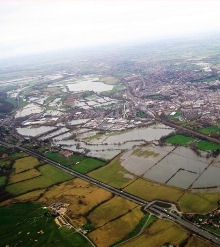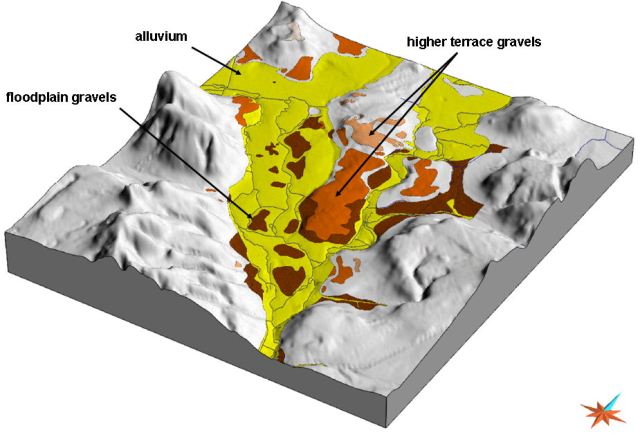Groundwater and flooding in Oxford
The British Geological Survey, in collaboration with the Environment Agency (EA), has investigated the causes of groundwater flooding in the urbanised areas of the River Thames floodplain within the city of Oxford. These insights have helped the EA in their development of a flood management strategy for the city.
Oxford: a flood-prone city
Oxford is situated within a narrow valley underlain by alluvial deposits from the River Thames. The city suffers from recurrent floods, for example, in 2007 in which approximately 200 properties were affected by a 1 in 20 year event, and in 2014.
A significant number of these properties were impacted by flooding from rising groundwater which was either the sole cause of flooding or the initial cause prior to inundation by fluvial waters.
Investigating the controls on groundwater flooding
The Groundwater and flooding in Oxford project is a collaboration between the BGS and the EA which has identified the factors that control groundwater flooding in the Oxford area and mapped areas prone to groundwater flooding.
The Environment Agency has been the primary funder of a comprehensive project monitoring network to measure the relevant components of the hydrological system. BGS has contributed to the design and installation of the monitoring network and is quality assuring the resulting data and making interpretations based on them.
The conceptual understanding of groundwater flow and surface water interaction has benefited from the construction of a detailed 3D geological model which in turn has formed the basis of a groundwater flow model.
Benefits of the project results
The project has informed the assessment being undertaken by the EA of potential measures to reduce the risk of flooding in Oxford. This includes the possible impact on natural habitats within the floodplain as a result of these measures.
The project has concluded that significant urban groundwater flooding could occur as a result of direct infiltration of rainfall alone. It has also shown that high river levels in the days following major rainfall events are very important in controlling groundwater flooding.
The project results have provided greater confidence that the main recommendation of the EA's Flood Risk Management Study, to improve the conveyance of flood waters through the Oxford valley during fluvial flood events, will also reduce groundwater flood risk.
Ongoing work to understand groundwater flood risk
The BGS continues to process and interpret data collected from the Oxford floodplain. This will aid the refinement of proposed flood mitigation measures. It will also improve the understanding of the dependence of the ecology of the study area on groundwater. A dataset of water levels is growing which provides a baseline against which to assess the impacts of the flood risk management scheme.
Work is also ongoing to link the groundwater model of the Oxford floodplain sediments and the River Thames model for the area. This would be used to simulate flood conditions and assess the design of flood mitigation schemes.
It is hoped that the Oxford floodplain can become a nationally important field observatory, building on the substantial monitoring network currently in place.
Publications
Macdonald, D M J, Dixon, A, Newell, A J, and Hallaways, A. 2012. Groundwater flooding within an urbanised flood plain. Journal of Flood Risk Management, 5, 68-80.
Macdonald, D M J, Bloomfield, J B, Hughes, A, MacDonald, A, Adams, B, and McKenzie, A. 2008 Improving the understanding of the risk from groundwater flooding in the UK. In: FLOODrisk 2008, European Conference on Flood Risk Management, Oxford, UK, 30 Sept –2 Oct 2008. The Netherlands, CRC Press.
Macdonald, D M J, Hall, R, Carden, D, Dixon, A, Cheetham, M, Cornick, S, and Clegg, M. 2007. Investigating the interdependencies between surface and groundwater in the Oxford area to help predict the timing and location of groundwater flooding and to optimise flood mitigation measures. Proceedings of 42nd Defra Flood and Coastal Management Conference.
Newell, A J. 2007. Morphology and Quaternary geology of the Thames floodplain around Oxford. British Geological Survey Open Report, OR/08/030.
Kessler, H, Mathers, S, Lelliott, M, Hughes, A G, and Macdonald, D M J. 2007. Rigorous 3D geological models as the basis for groundwater modelling. Proceedings of the Annual Meeting of the Geological Society of America, Denver, Colorado, USA, 27 October 2007.
Contact
Contact David Macdonald for further information.








